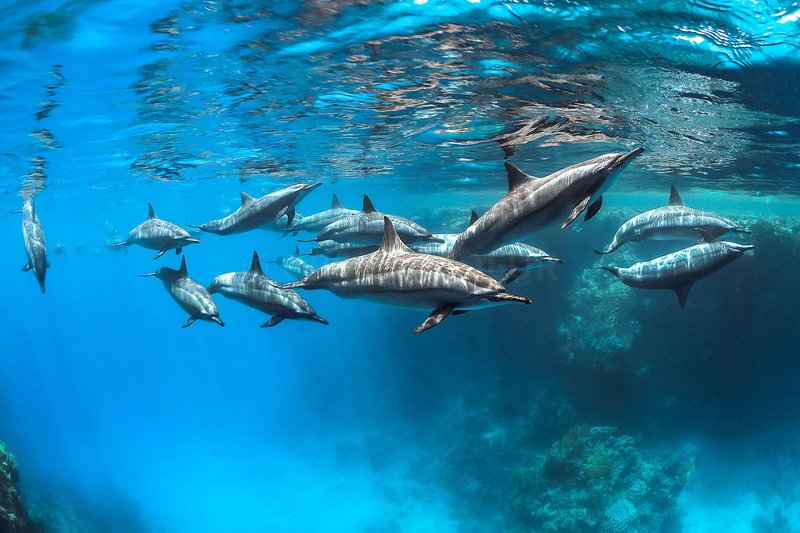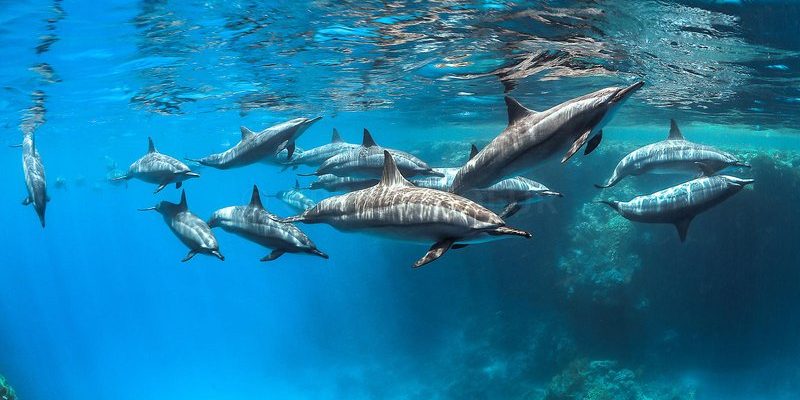
Let’s dive deeper into what makes spinner dolphins so fascinating. From their streamlined bodies to their sophisticated social behaviors, these creatures have honed their skills over millions of years. Understanding these adaptations not only showcases the beauty of nature but also reminds us how interconnected all living things are within an ecosystem.
Streamlined Bodies for Speed
One of the first things you notice about spinner dolphins is their sleek, streamlined bodies. These shapes are no accident; they are adaptations that help them move swiftly through the water. Imagine trying to run through a crowded room versus gliding through an open space. The dolphin’s body is designed to reduce drag, allowing it to swim at impressive speeds of up to 20 miles per hour!
This streamlined shape is paired with powerful flippers that enable sharp turns and quick movements. When a predator like a shark comes lurking, these adaptations become lifesavers. Spinner dolphins can quickly dart away, making their escape not just about speed but also about agility.
Benefits of a Streamlined Body:
- Speed: Helps them escape predators.
- Agility: Allows for impressive aerial flips and spins.
- Energy Efficiency: Reduces fatigue during long swims.
Echolocation: Nature’s Sonar
Ever heard of sonar? It’s that technology submarines use to detect objects underwater. Spinner dolphins have something similar built right into their biology called echolocation. This allows them to “see” their environment using sound waves. Here’s how it works: they emit sounds that bounce off objects, and by listening to the echoes, they can determine the location and size of those objects.
This adaptation is especially vital when hunting for fish or navigating through murky waters where visibility isn’t great. Imagine trying to find your way around a dark room—you’d rely on your other senses, right? For these dolphins, echolocation is their guiding light, giving them a clear understanding of their surroundings.
Importance of Echolocation:
- Hunting: Enables them to locate prey even in darkness.
- Navigation: Helps them avoid obstacles in the ocean.
- Communication: Allows them to interact with other dolphins.
Social Structures and Group Dynamics
Spinner dolphins are highly social animals, often found in groups called pods. These pods can range from a handful of dolphins to several hundred! Living in groups offers numerous advantages. For one, it enhances their echolocation abilities. When multiple dolphins are sending out clicks and whistles, the echoes help create a fuller picture of the environment.
You might be wondering why such social behavior matters for survival. Well, being in a pod helps spinner dolphins cooperate during hunting. They can herd fish into tight balls, making it easier for everyone to feed. Plus, there’s safety in numbers. When they swim together, it’s harder for predators to target an individual dolphin.
Benefits of Social Structures:
- Cooperative Hunting: Increases food efficiency.
- Protection: Better defenses against predators.
- Learning: Young dolphins pick up skills from older members.
Skin Adaptations for Hydrodynamics
Another remarkable adaptation is the skin of the spinner dolphin. Their skin is smooth and plays a crucial role in streamlining their body and reducing friction as they swim. This smoothness isn’t purely aesthetic; it helps them glide through water with minimal effort.
Additionally, this skin has special microstructures that help them maintain their body temperature. Dolphins, like us, can find themselves cold from time to time. Their skin works like a natural wetsuit, ensuring they stay warm as they dive into colder depths.
Importance of Skin Adaptations:
- Reduced Friction: Enhances swimming efficiency.
- Temperature Regulation: Maintains warmth in various water conditions.
- Healing: Fast regeneration abilities to recover from injuries.
Breath-Holding and Diving Skills
Let’s talk about breathing. Spinner dolphins are capable of holding their breath for up to 10 minutes while diving. This capability is linked to their efficient respiratory system. Their lungs are designed to exchange gases effectively, allowing them to take in large amounts of oxygen in one breath.
When they dive, their heart rate slows down, directing blood to essential organs. This adaptation helps them conserve energy and oxygen while exploring deeper waters for food or avoiding predators. It’s like having a high-performance engine in a sports car—perfect for those high-speed chases!
Benefits of Breath-Holding Capabilities:
- Extended Diving: Access to deeper food sources.
- Predator Evasion: Longer periods below the surface.
- Efficient Energy Use: Minimizes fatigue during hunts.
Communication Skills and Social Interaction
Did you know that spinner dolphins are quite talkative? They communicate through a series of clicks, whistles, and body movements. These vocalizations are essential not just for hunting and navigation but also for bonding with other dolphins in their pod. It’s like having a dial-up conversation with your friends while playing a game—everyone can share strategies and keep in touch!
Their communication skills play a significant role in building social structures and enhancing group cohesion. In some studies, dolphins have been shown to even mimic each other’s sounds, showcasing their intelligence and adaptability. Imagine if you could learn new languages by just hanging out with people—it’s similar for these clever creatures!
Importance of Communication Skills:
- Social Bonding: Strengthens group dynamics.
- Coordination: Helps organize hunting efforts.
- Learning: Transmits knowledge in the pod.
As we wrap up this exploration of adaptations that help spinner dolphins thrive underwater, it’s clear that these incredible creatures are finely tuned to their environment. Their streamlined bodies, sophisticated communication, and social behaviors all work together to ensure their survival. It’s a beautiful reminder of how nature crafts solutions for living beings to flourish in their ecosystems. Understanding these adaptations not only brings us closer to these fascinating animals but also emphasizes the larger message of conservation and the importance of protecting their habitats for generations to come.

